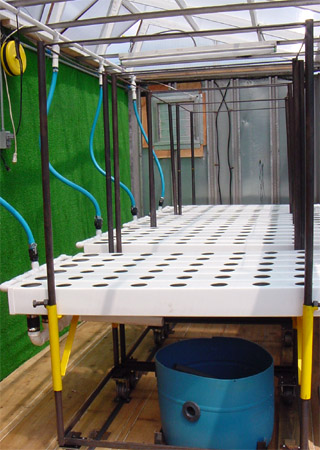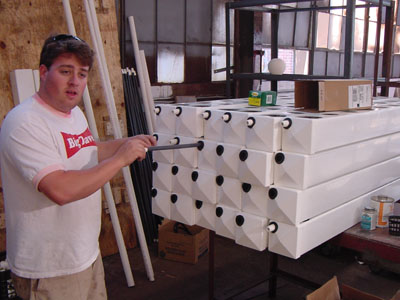
Construction and Implementation of the hydroponic
system.
The central motivation in the design of the hydroponic system has been efficiency
and ease of use. For hydroponics to become a viable alternative to soil production,
systems have to be designed to require a minimum of input resources, most
importantly labor. The system will consist of a recirculation aeroponic unit
comprised of a series of growth chambers and a single large reservoir. The
system will be constructed largely of agricultural grade PVC. The growth chambers
will be arranged into beds with a “floating isle” configuration
to maximize space efficiency. The plant roots will be suspended in a highly
oxygenated nutrient rich solution circulated by electric pump. The reservoir
will be monitored for PH and nutrient content as it is replenished to allow
for plant absorption and evaporation. Monitoring equipment to control nutrient
condition as well as thermostatic controls will help to achieve significant
automation. Similarly, environmental controls such as a misting system and
radiant heating will provide adequate temperature control so the greenhouse
can be operated year round.
Further Developments
As the system becomes more refined, efforts will be made to introduce elements
that will enhance the environmental sustainability of the project as the participants
learn how to make the UAU more efficient. The addition of a “Living
Machine” will allow the team to use plants and micro-organisms to filter
and treat waste water through natural processes. The living machine’s
economy and efficiency make it a perfect match when working in conjunction
with a hydroponic system. Another important element will be the addition of
solar and wind power generation that will lessen, and possibly eliminate,
the electricity needs of the greenhouse. Up to seven large solar panels and
two wind generators could be fitted to the greenhouse, improving the greenhouse’s
efficiency by minimizing its use of scarce natural resources. Through ecological
engineering, we can reduce the amount of virgin resources it takes to grow
food.

